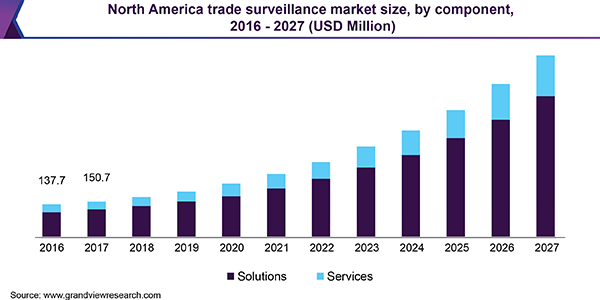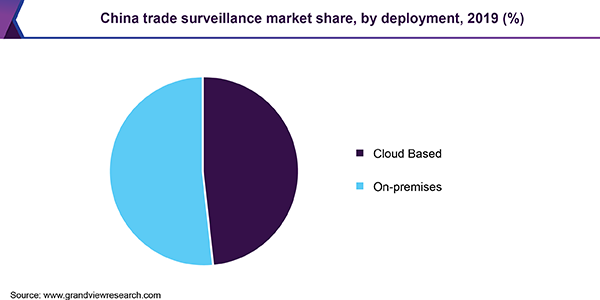- Home
- »
- Next Generation Technologies
- »
-
Trade Surveillance Market Size, Industry Report, 2020-2027GVR Report cover
![Trade Surveillance Market Size, Share & Trends Report]()
Trade Surveillance Market Size, Share & Trends Analysis Report By Component, By Deployment (Cloud, On-premise), By Region (North America, Europe, APAC, MEA, LATAM), And Segment Forecasts, 2020 - 2027
- Report ID: GVR-4-68038-187-0
- Number of Report Pages: 80
- Format: PDF, Horizon Databook
- Historical Range: 2016 - 2018
- Forecast Period: 2020 - 2027
- Industry: Technology
Report Overview
The global trade surveillance market size was valued at USD 717.4 million in 2019 and is expected to expand at a CAGR of 19.7% over the forecast period. The market is expected to witness incremental growth owing to the increasing need for security as well as increasing occurrences of data manipulation and fraud in the financial institutes. The trade surveillance systems solutions help enterprises and market experts to spot fraud, erroneous, or abusive trading. This further helps enterprises and market experts to prevent fraud, update trading strategies in lesser time, and comply with government regulations. Trade surveillance systems are majorly used by IT service providers, government regulators, consulting firms, and system integrators, among others.
Data breaching of internal policies is a major factor responsible for rapidly increasing unlawful trading in financial institutes, which is increasing the demand for surveillance systems that can detect trading rule violations. Also, transparency and oversight in the current market trade can be achieved with the help of the trade surveillance system. Trade surveillance methods include behavioral analysis and trading pattern recognition, which offers identification of potential violators before the incidence.

In recent years, trading techniques have shifted from labor-intensive to automatic and algorithmic trading. These advanced trading techniques have improved market capacity, thereby reducing human limitations. On the contrary, it has also expanded the risk of trade manipulation, fraud, and violations. To overcome these, the financial institutions and trade exchange firms are leveraging trade surveillance systems that help in monitoring risk, fraud cases, and market abuse.
Moreover, with technological changes and automatic trading dominating the marketplace, speed has become the primary factor of high-frequency trading where users have shifted from seconds to microsecond operations. This has amplified the chances of market manipulation and frauds, which has made trade surveillance systems a mandatory requirement for trading. Furthermore, increasing fraud and scandals are anticipated to create new opportunities for providers in the coming years.
Several participants in the private sector are also engaging in market surveillance. For instance, the SMARTS Trade Surveillance, a NASDAQ OMX product supports individual trade exchanges as well as governing agencies in monitoring trading activities across multiple markets. Third-party providers such as IBM (Surveillance Insight for Financial Services) assist in customization and set-up of surveillance capabilities for other major exchanges such as NYSE Euronext.
Component Insights
Trade surveillance providers offer several types of solutions such as risk and compliance, reporting and monitoring, surveillance and analytics, and case management. These providers offer trade surveillance services including managed and professional services. The solution segment accounted for the highest market share in 2018 and is likely to maintain its dominance over the forecast period. The growth of this segment is attributed to various benefits such as optimization of surveillance data, improved compliance management, and streamlining of case management. Furthermore, the rising adoption of internal compliances and strict regulatory norms by exchange departments and financial institutions are the key factors for increased adoption of trade surveillance solutions.
The surveillance and analytics segment is anticipated to register considerable growth over the forecast period. The growth can be attributed to benefits such as systematic collection and analysis of outcomes from collected data used in planning, evaluating, and implementing compliance policies and practices. It also helps in improving the present surveillance process thus delivering better proficiency and accuracy.
Deployment Insights
The on-premises segment held the largest market share of approximately 47% in 2019 owing to associated benefits such as easy integration with the enterprise's existing IT infrastructure and high level of data security than cloud-based trade surveillance systems. On-premise trade surveillance systems offer data security through pre-trading monitoring, which includes pattern recognition and behavioral analysis.
There as several companies that have sensitive information, such as government and banking industries, which look for a certain level of security and privacy that on-premise environment provides. For instance, Nasdaq, Inc. SMARTS Trade Surveillance solutions offer insights on an individual’s actions in the perspective of market conditions, associated groups, and their own particular norms, allowing to reveal vicious behaviors and traders that are more prone to manipulate the market based on their activities.

The cloud segment held the largest share of the trade surveillance market with approximately 40% revenue share in 2019. Cloud-based trading activity is opening up as a new emerging trend in trading as it promotes digitalization. Also, increasing adoption among small, medium, and large enterprises and freelancers is boosting the demand for cloud-based trade surveillance systems in the market. The cloud-based trade surveillance system helps in transforming application development, infrastructure, deployment, and delivery processes of these enterprises while increasing efficiency and saving 80% of storage costs.
Regional Insights
Europe accounted for the largest market share in 2019 with around 30% of the revenue generated worldwide owing to the large adoption of cloud-based trade surveillance systems by enterprises and trading regulations imposed by the government. In the current market scenario, the U.K., Germany, and Sweden are the top suppliers in this region. Besides, Market Abuse Directive (MAD), Market Abuse Regulation (MAR), and MiFID2 regulations are also acting as the key factors responsible for the adoption of trade surveillance systems solutions and services in this region. MiFID2 came into effect in 2018 and helps financial institutions to move all transactions to electronic platforms for better auditing and ensures transparency of workflow to investors.
North America accounted for the second-largest market share in 2019 with approximately 20% of the revenue generated worldwide due to the presence of a large number of wealth management firms and financial institutions and growing digitalization. Asia Pacific is also likely to offer lucrative growth opportunities for the market. Rising investment by financial institutions to meet compliance is a major driving factor in the region.
Trade Surveillance Market Share Insights
Some of the prominent players in the market are NICE Systems; Crisil Limited; Aquis Technologies; Scila AB; OneMarketData, LLC; IPC System, Inc.; B-Next; ACA Compliance Group; Red Deer (Jersey) Ltd.; Nasdaq, Inc.; and SIA S.P.A. Trade surveillance providers are focusing on new product development, product enhancement, and partnerships which in turn would help increase their market presence. For instance, in April 2018, Nasdaq, Inc. announced that Gemini Trust Company, LLC, a next-generation digital asset exchange and custodian company, will be leveraging Nasdaq’s SMARTS Trade Surveillance technology to monitor its marketplace. This technology will enable Gemini to monitor all of its trading pairs, including, BTC/ETH, BTC/USD, and ETH/USD.
Report Scope
Attribute
Details
Base year for estimation
2019
Actual estimates/Historical data
2016 - 2018
Forecast period
2020 - 2027
Representation
Revenue in USD Million and CAGR from 2020 to 2027
Regional scope
North America, Europe, Asia Pacific, Latin America, and MEA
Country scope
U.S., Canada, U.K., Germany, France, China, India, Japan, Brazil, Mexico
Report coverage
Revenue forecast, company ranking, competitive landscape, growth factors, and trends
15% free customization scope (equivalent to 5 analysts working days)
If you need specific information that is not currently within the scope of the report, we will provide it to you as a part of the customization.
Segments Covered in the ReportThis report forecasts revenue growth at the global, regional, and country levels and provides an analysis of the latest industry trends in each of the sub-segments from 2016 to 2027. For the purpose of this study, Grand View Research has segmented the global trade surveillance market report on the basis of component, deployment, and region:
-
Component Outlook (Revenue, USD Million, 2016 - 2027)
-
Solutions
-
Risk and Compliance
-
Reporting and Monitoring
-
Surveillance & Analytics
-
Case Management
-
Others
-
-
Services
-
Managed
-
Professional
-
-
-
Deployment Outlook (Revenue, USD Million, 2016 - 2027)
-
Cloud
-
On-premises
-
-
Regional Outlook (Revenue, USD Million, 2016 - 2027)
-
North America
-
The U.S.
-
Canada
-
-
Europe
-
The U.K.
-
Germany
-
France
-
-
Asia Pacific
-
China
-
India
-
Japan
-
-
Latin America
-
Brazil
-
Mexico
-
-
Middle East & Africa
-
Frequently Asked Questions About This Report
b. The global trade surveillance market size was estimated at USD 717.4 million in 2019 and is expected to reach USD 843.71 million in 2020.
b. The global trade surveillance market is expected to grow at a compound annual growth rate of 19.7% from 2020 to 2027 to reach USD 2,976.7 million by 2027.
b. Europe dominated the trade surveillance market with a share of 32.6% in 2019. This is attributable to large adoption of cloud-based trade surveillance systems by enterprises and trading regulations imposed by the governments in the region.
b. Some key players operating in the trade surveillance market include NICE Systems; Crisil Limited; Aquis Technologies; Scila AB; OneMarketData, LLC; IPC System, Inc.; B-Next; ACA Compliance Group; Red Deer (Jersey) Ltd.; Nasdaq, Inc.; and SIA S.P.A.
b. Key factors that are driving the market growth include increasing need for security in the wake of increasing occurrences of data manipulation and fraudulent activities.
Share this report with your colleague or friend.
![gvr icn]()
NEED A CUSTOM REPORT?
We can customize every report - free of charge - including purchasing stand-alone sections or country-level reports, as well as offer affordable discounts for start-ups & universities. Contact us now
![Certified Icon]()
We are GDPR and CCPA compliant! Your transaction & personal information is safe and secure. For more details, please read our privacy policy.
We are committed towards customer satisfaction, and quality service.
"The quality of research they have done for us has been excellent."





